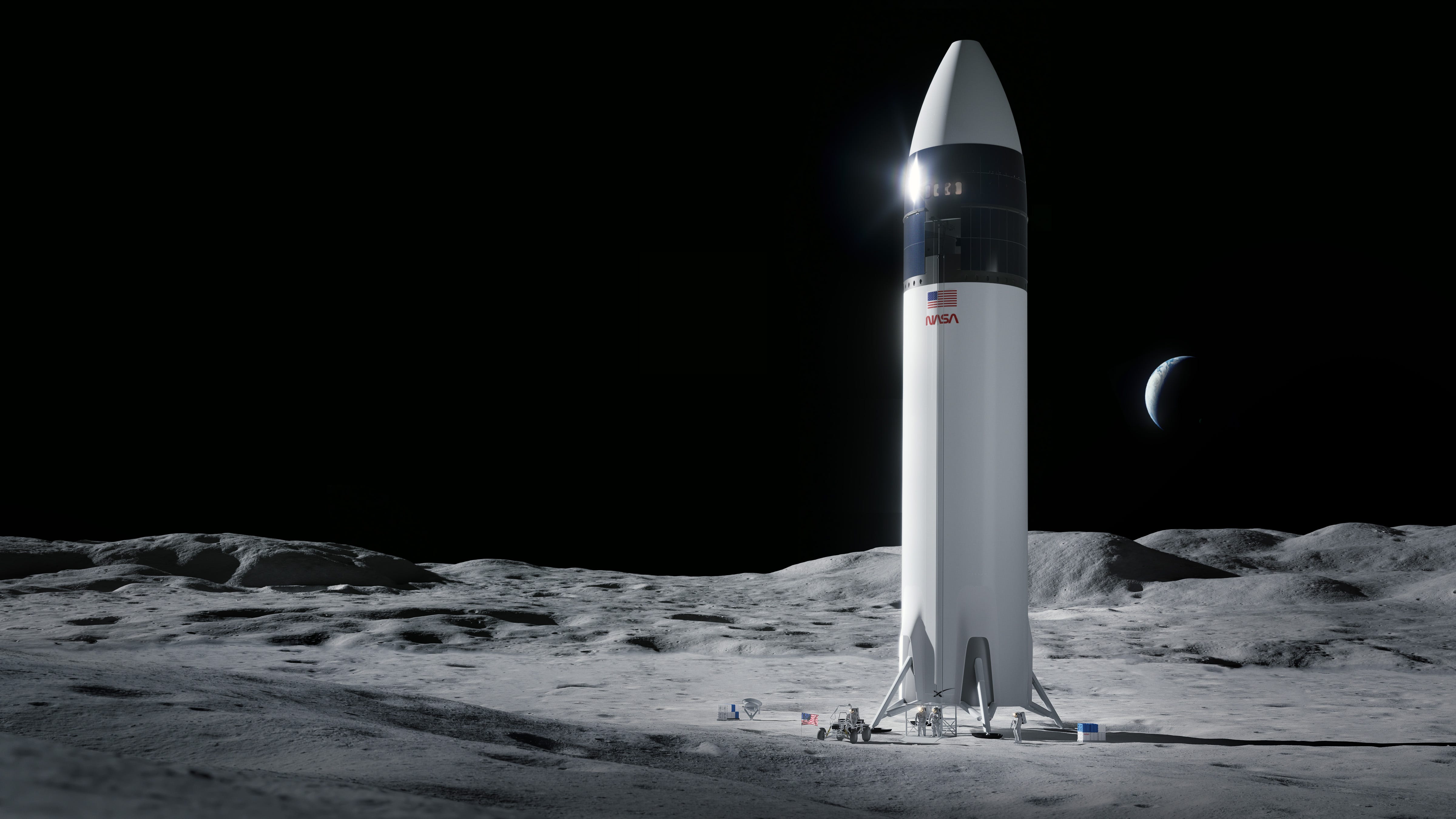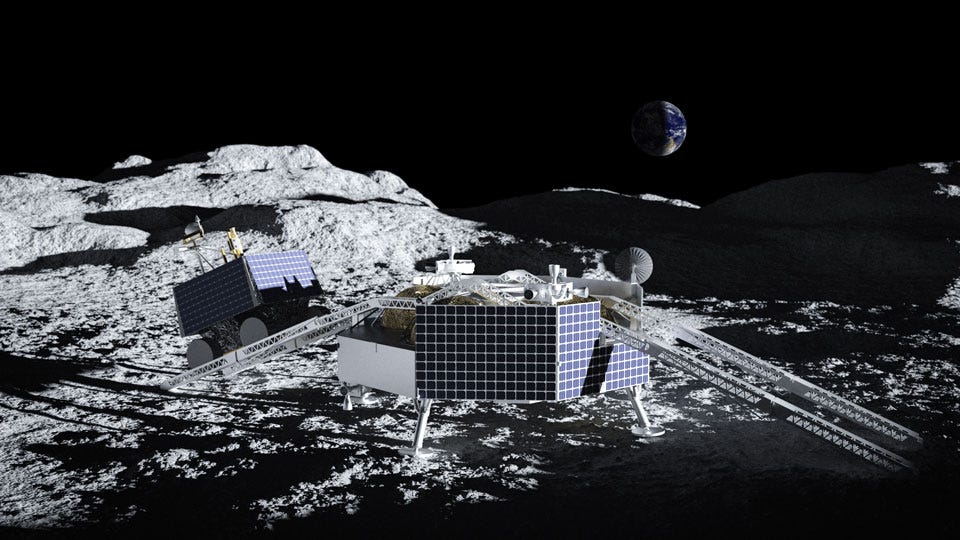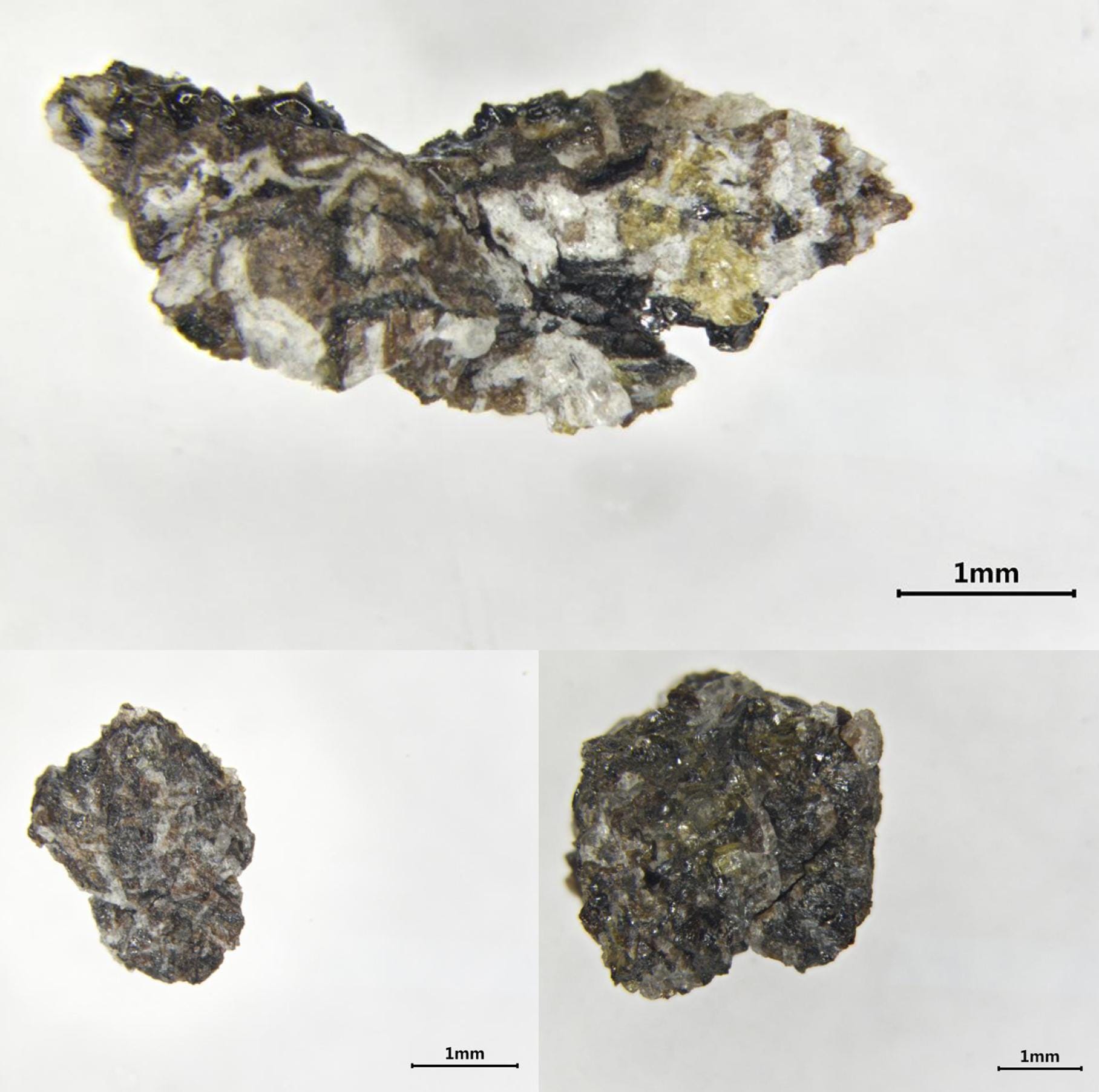Moon Monday Issue #23
SpaceX Starship to land NASA astronauts on the Moon, UAE's lunar rover hitches ride on Japanese lander, Astrobotic selects Falcon Heavy for VIPER flight, Chang'e 5 samples database, and more.
Highlight
In a move that surprised nearly everyone, NASA announced on April 16 that it has selected SpaceX Starship to mark the historic return of astronauts to the Moon as part of the Artemis III mission. SpaceX will receive $2.89 billion over the next few years to develop Starship––about the same as what NASA spends on the SLS rocket and associated ground systems each year. For the mission, a lunar version of the Starship will dock with NASA’s SLS-launched crewed Orion spacecraft––not the Gateway––in lunar orbit. Two out of four astronauts on Orion will transfer to Starship to land on the Moon and return to Orion after approximately a week. For the stay on the Moon, Starship includes a spacious cabin, and two airlocks with their own life support systems for astronaut moonwalks. It’s not clear at this point if NASA will use the much higher capacity of Starship to bring more lunar samples instead of just using Orion.

While NASA intended to select two companies for developing the lunar Human Landing System to maintain competition, the U.S. Congress providing only $850 million for the same for this fiscal year––4x less than the required amount––lead NASA to select only one provider. The source selection statement explains why SpaceX’s proposal won over bids by Blue-Origin-led National Team and Dynetics. The whole document is worth reading but the short of it is that apart from its significantly lower cost, Starship’s ability to deliver large and massive payloads to the Moon convinced NASA of it being useful for the agency’s long term Moonbase and ‘Moon to Mars’ plans, both of which have never looked more realistic. The document also states that SpaceX will self-fund and assume financial risks for over half of Starship’s development, further sweetening the deal for NASA. To alleviate the risks in using Starship, SpaceX proposed to NASA that it will perform a demonstration flight for in-space propellant transfer in Earth orbit, convinced them of the flexibility available in timelines for the same during a mission, and added that they’ll land an uncrewed Starship on the Moon before the mission to land humans.
The National Team and Dynetics still have a shot at landing humans on the Moon later as NASA’s press release says there will be a separate contract for companies to bid for Artemis Moon landing missions after the first crewed Lunar Starship one, the details of which are expected to be released this year. Interestingly, NASA’s press release doesn’t mention the previously announced 2024 date for Artemis III. It’s clear that Starship’s developmental pace and milestones will be a major factor in determining the mission date, apart from any delays with the SLS rocket. The award also means that NASA will now officially consider the capabilities of Starship as part of the Artemis architecture as it re-plans the program. Meanwhile, an upgraded Starship prototype, SN15, is preparing for flight this week, set to draw more eyes on Starship’s development than ever before.
Exploration
Further strengthening UAE’s and Japan’s space collaboration, UAE has selected Japan-based ispace to carry their 10-kilogram Rashid rover on the company’s maiden Moon landing mission launching on a SpaceX Falcon 9 rocket in 2022. As part of the deal, with undisclosed price details, ispace will provide wired communication and power to the rover during cruise, and wireless communication via their lander to and fro Earth. Notably, ispace is also part of the team led by the U.S. company Draper, which was selected by NASA to compete for sending cargo to the Moon’s surface as part of the agency’s CLPS program. Further, ESA has selected ispace Europe to be part of the Science Team for PROSPECT, a program aiming to extract lunar water.
Astrobotic has selected SpaceX’s Falcon Heavy rocket to launch its Griffin lander to the Moon in late 2023. Griffin will carry NASA’s 430-kilogram VIPER rover to the Moon’s south pole, a mission part of the agency’s CLPS program, to map water ice and other resources in and around permanently shadowed regions. Astrobotic didn’t disclose the cost of their Falcon Heavy ride, or which other launch options they considered, but NASA had awarded Astrobotic $199.5 million for delivering VIPER, with the launch vehicle selection left to the company. For its first CLPS mission, with a smaller lander than Griffin, Astrobotic has chosen ULA’s Vulcan Centaur as the launch vehicle, currently scheduled to take off at the end of the year.

After a successful hot fire test of all four engines of NASA SLS rocket’s core stage, engineers have refurbished it. It will now be shipped to the agency’s Kennedy Space Center this month to stack it with the other parts of the rocket, which are also almost done, for the Artemis I launch either later this year or in early 2022.
Extending NASA’s commercial model, the agency is seeking industry feedback to purchase spacesuit services from at least one commercial partner rather than only build suits in-house with traditional government contracts. NASA intends to use the suits and associated hardware at the International Space Station, Gateway lunar station, and Artemis lunar surface missions. On the Moon, the suits will be used for walking, driving rovers, collecting samples, and conducting other research activities. However, NASA will continue their in-house efforts in parallel with this commercial purchase. Responses are due April 29, 2021.
NASA is yet to formally start its contract with SpaceX, over a year after announcement, for delivering cargo to the NASA-led Gateway lunar station using the company’s Dragon XL spacecraft. NASA told SpaceNews on April 14 that it has yet to formally authorize SpaceX to proceed on the contract because the agency is re-evaluating the Artemis program’s schedule with the current program budget.
Science
China’s space agency has established a lunar sample expert committee to manage the Moon samples brought to Earth by Chang’e 5. The committee consists of nine experts, to be chaired by Zhu Rixiang of the Institute of Geology and Geophysics of the Chinese Academy of Sciences. China has also created a nice lunar sample information database. These developments follow China’s announcement in January about how the Chang’e 5 samples will be made available to international scientists for study.

The Moon has literal faults all over it. Most of them are young, which suggests the Moon is shrinking. To better understand exactly how, scientists have made a new comprehensive stress and tectonics model that considers the effects of multiple stress-generating mechanisms simultaneously. This will help us understand not just how the Moon evolves but also how bodies across the solar system do.
A new study estimates the amount of water and other volatiles in the Moon’s interior. They do this by modeling how volcanic eruptions deposit such volatiles on the Moon’s surface and how much of it is retained or lost, and comparing that with remote sensing data to calibrate the predictions. While many early measurements of Luna and Apollo samples suggested the Moon’s interior lacks highly volatile elements, recent high‐precision studies argue that it may be more water-rich than previously thought.
Thank you Sonia Tikoo and Nathan Price (Countdown to the Moon) for supporting me and powering this edition of Moon Monday.
Everyone, I’m publishing this one-of-a-kind Moon exploration newsletter for free, with no ads. And it will stay that way. If you like my work, support me to keep it going. Monthly supporters will be credited in future Moon Monday issues with a link to their website/social.
